крутилка просто на декатроне
(это будет раздел сделай сам, нужен паяльник а схема и как сделать -здесь. Многие увлекаются, делают самоделки.)
Dieter’s
K8A Dekatron Spinner
last update (and finished): November-25-2007
Back to Dieter’s Nixie Tube Page
Email to Dieter
What is a Dekatron spinner?
A Dekatron spinner displays a spinning dot by using a vintage ‘Dekatron’ style glow-transfer counting tube.
The colour of the dot depends to the gas the tube is filled.
Neon filled tubes display a red-orange dot.
Argon filled tubes display a purple dot.
The spinning frequency depends to the mains voltage the spinner is connected to and to the counting steps of the Dekatron.
If the spinner is connected 50Hz and the Dekatron is a 10-way counter (like the one here in this project) the dot spins with 5 turns per second.
If the spinner is connected to 60Hz the dot spins with 6 turns per second.
An animation of a Dekatron spinner:

You can find more information about Dekatrons here on my Dekatron page.
The main idea of this project was to develope a simple Dekatron spinner for all known Dekatrons with K8A base.
I took my B13B Deaktron spinner circuit and modified it to this purpose..
After my modifications I came to this circuit: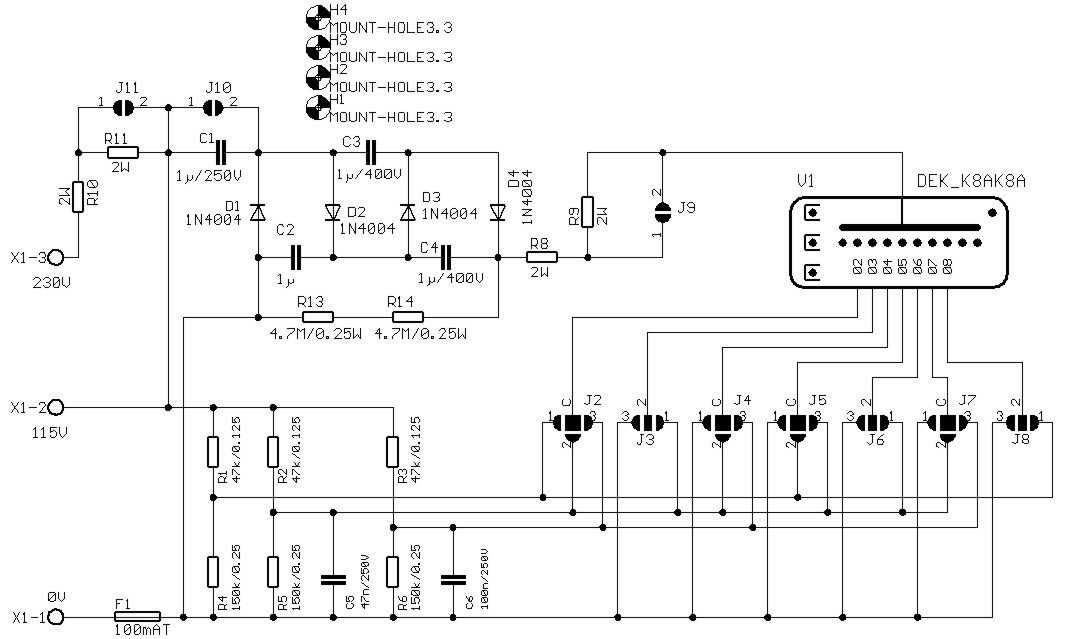
The circuit works with 230VAC/50-60Hz and 115VAC/50-60Hz.
All K8A Dekatrons I know will work in this circuit.
These are the following:
CV2271; Z303C; GC10B; GC10B/S; 6802; CK6802; 6909; CK6909; GC10B/L; CV6044; GC10/4B/L; CV6100; VX9194/4B; GC10/4B; CV1739; VX9194; M2465-401C; GC12/4B; GC10D; CV5143; 6482; Z302C; OG3(ОГ3); OG4(ОГ4); OG5(ОГ5); OG5-II-60(ОГ5-II-60); OG7(ОГ7); OG8(ОГ9); OG9(ОГ9); CT783.
Here you see the layout of the circuit: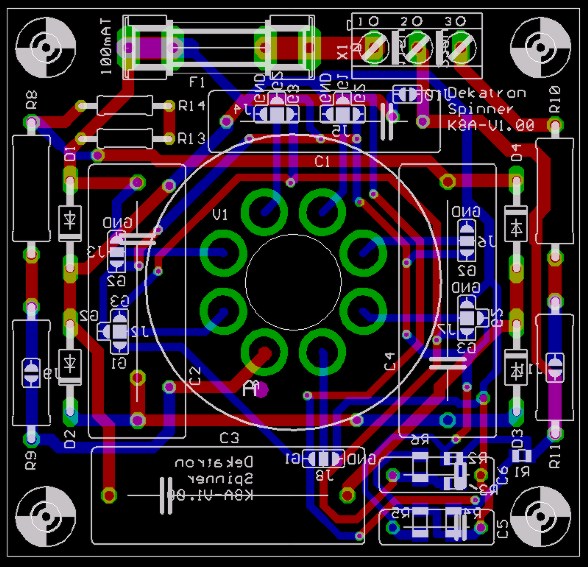
Here you see the finished board (unequipped):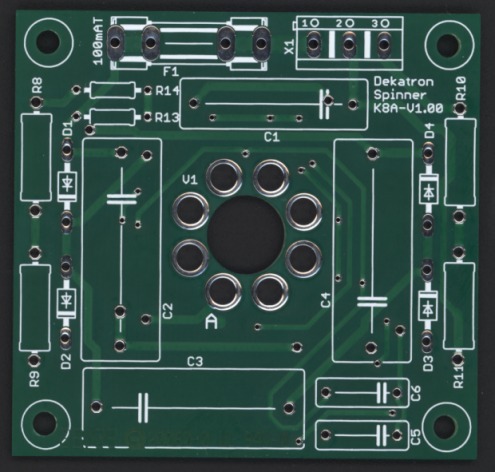
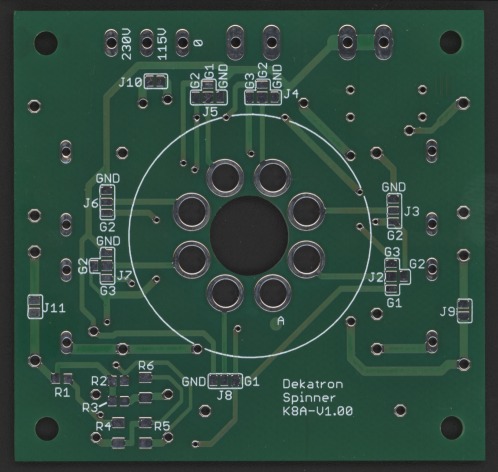
Here you see the spinner with different tubes:
Z303C (Adzam)
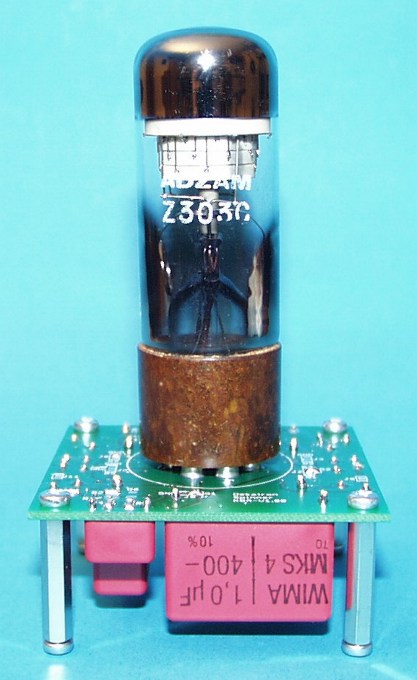
CV2271 (Mullard)

GC10B (Trigon)
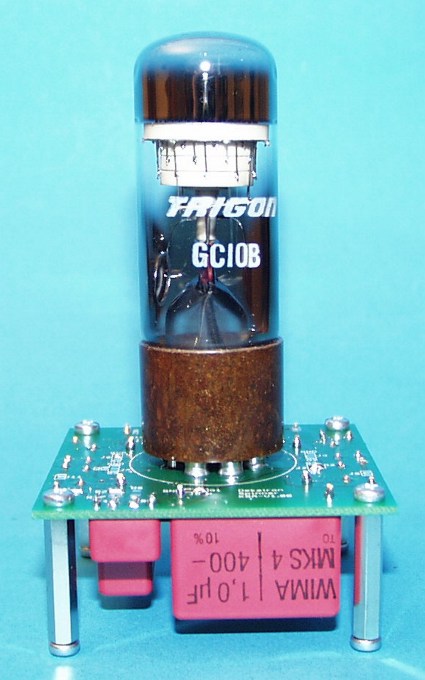
GC10/4B (Hivac)
GC12/4B (ETL / Baird Atomic)
OG3 (ОГ3) (Reflector/Sovtec)
This pictures show the configuration of the board for the OG3 Dekatron as example:
220-230v ( у меня 12 вольт питание – mc34063 по схеме повышающего с трансформатором . Часы от батареи для ноутбука, в дачном доме свет включается вечером – подзаряжаются батареи. Декатронам надо 450 .. 490 вольт, лампы ин-14 зажигаются от 180, все неонки через резистор у ламп 33 килоома, у декатрона 680 килоом.)
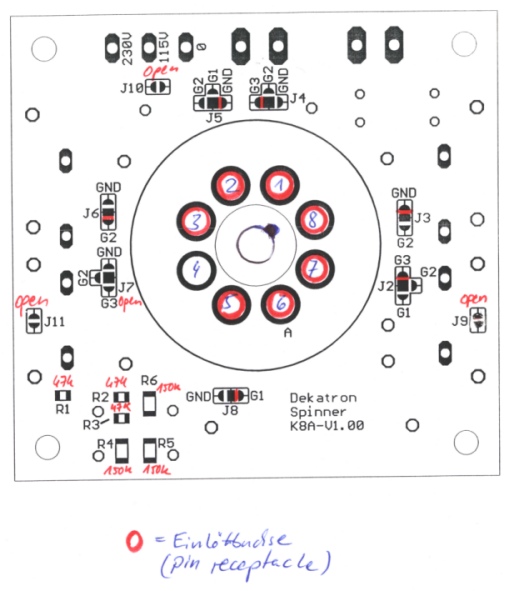

OG4 (ОГ4) (Reflector/Sovtec)
CT783 (Sylvania)
GC10D (Hivac)
This pictures show the configuration of the board for the GC10D and the CV5143 Dekatron as example:
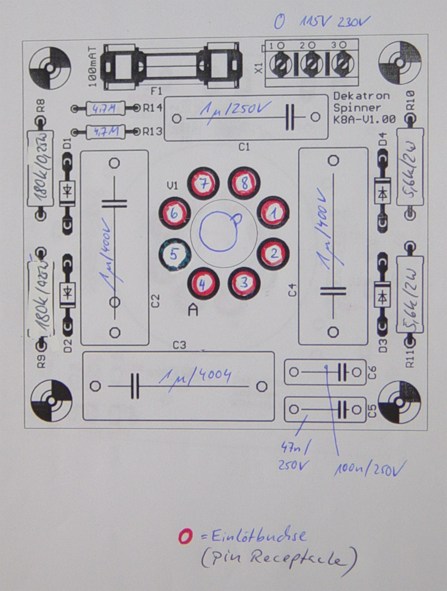

CK6802 (Raytheon)
6802(Sylvania):
6909 (Sylvania)
DK23 (Rodin)
VX9194 CV6044 (ETL)
GC10/4B (ETL/Baird Atomic)
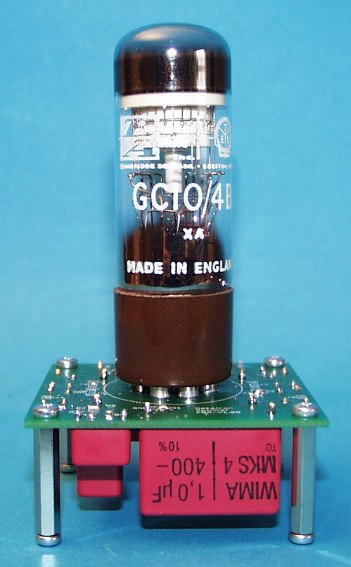
GC10/4B (Etelco)
The bottom side of the board: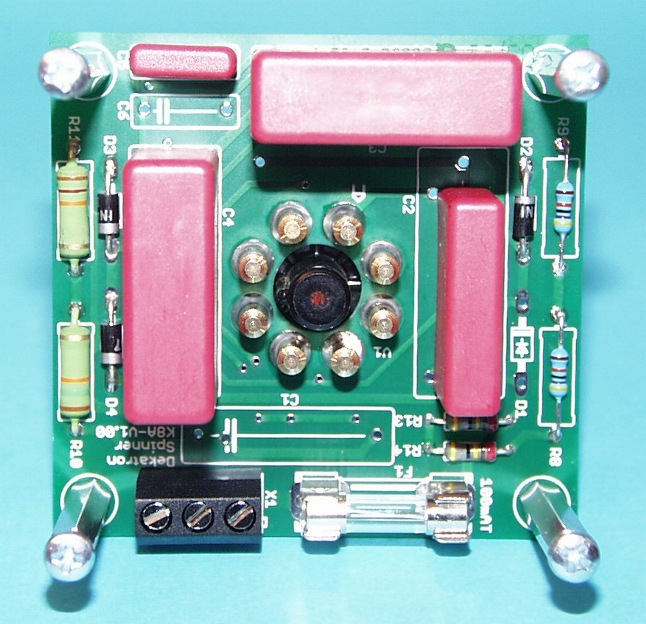
The tube is mounted in pin receptacles, so it’s no problem to replace it: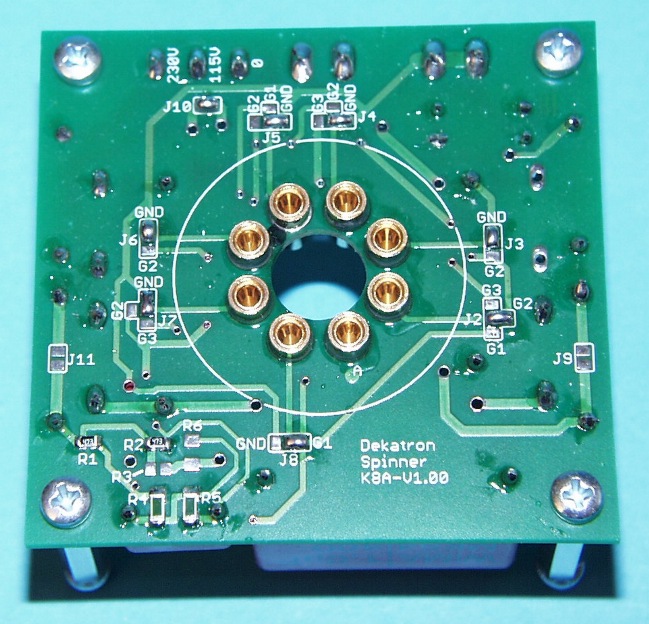
The following pictures show the tube spinning.
Of course, only one of the cathodes is glowing, but the opening time of the camera leads to that different pictures:
a middle opening time of the camera: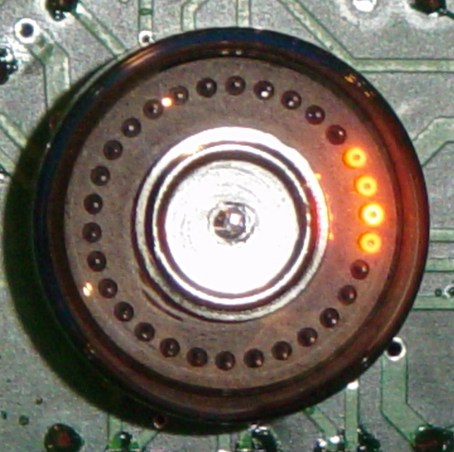
a short opening time of the camera: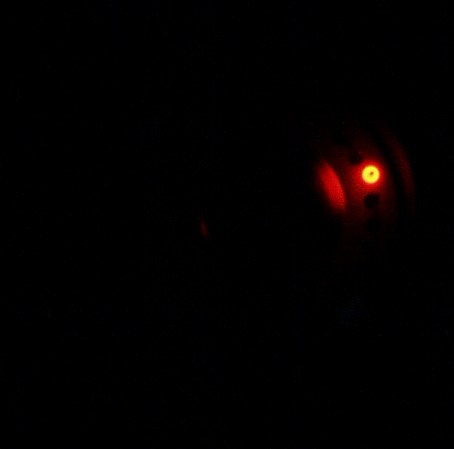
a long opening time of the camera: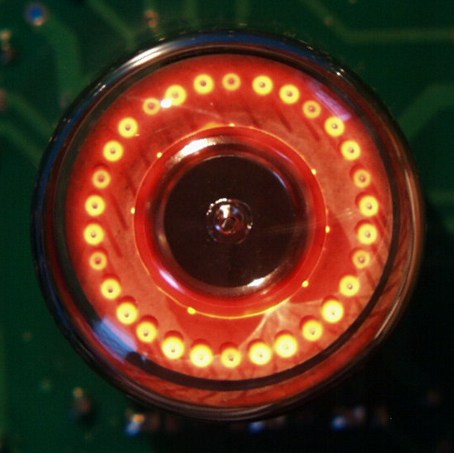
by night, with long opening time of the camera: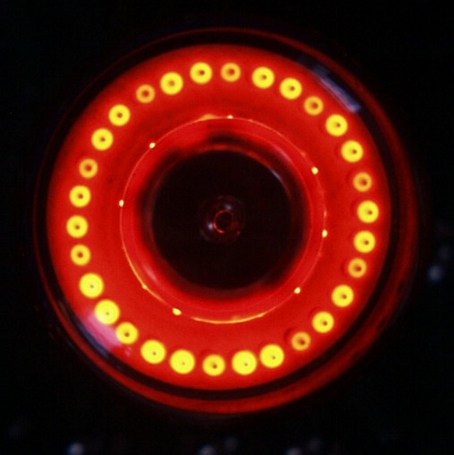
The wonderful purple glow of Argon filled tubes:
a long opening time of the camera: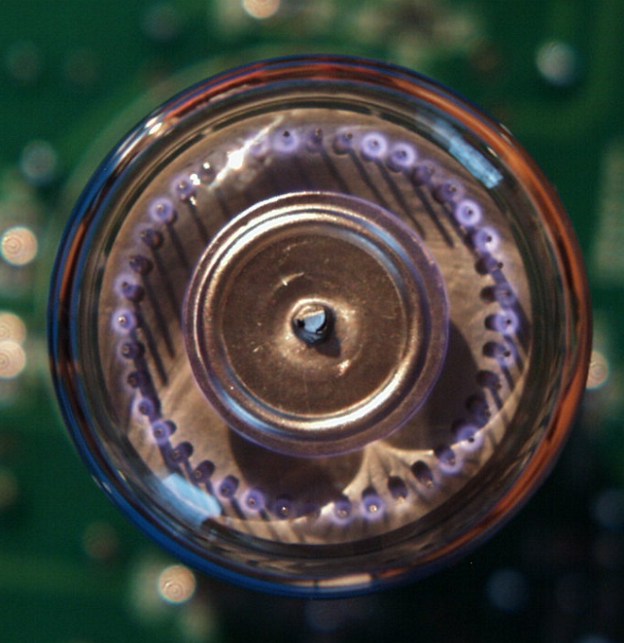
a short opening time of the camera: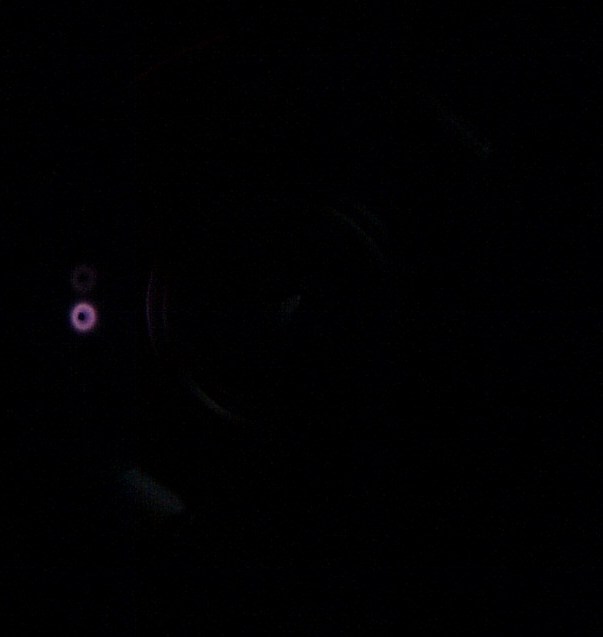
by night, with long opening time of the camera: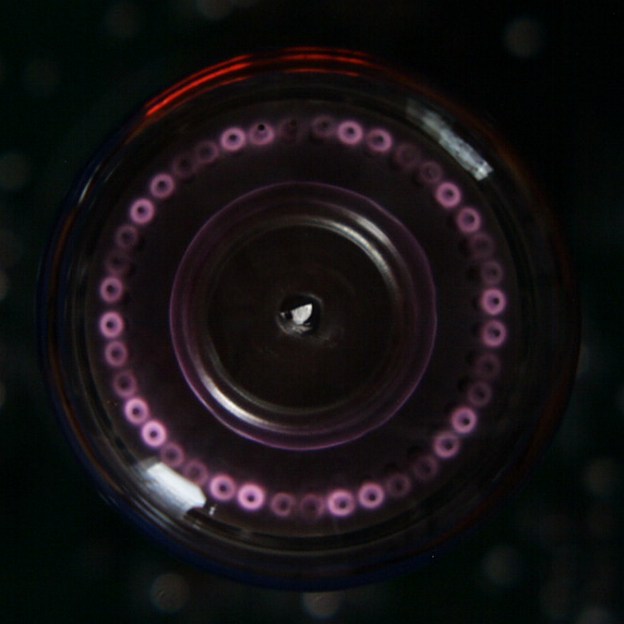
An animation of a spinning dekatron:
You can download the connection-instructions here.
Attention!!!!
This circuit generates high voltage!!!
DANGER!!!!
Attention!!!! This circuit generates high voltage!!! Do never touch the circuit while it is connected to the AC line. Before you use the circuit mount it in a closed housing! I am not liable for any damages caused to someone’s health.
Dekatron Spinners produce high voltages that can be fatal.
I disclaim any responsibility for injury as a result of using this circuit!!
All risks and damages, incidental or otherwise, arising from the use or misuse of this circuit are entirely the responsibility of the user.
DANGER!!!! HIGH VOLTAGE DEVICE!!!!!!
The author assumes no liability for any incidental, consequential or other liability from the use of this information. All risks and damages, incidental or otherwise, arising from the use or misuse of the information contained herein are entirely the responsibility of the user. Although careful precaution has been taken in the preparation of this material, the author assume no responsibility for omissions or errors.
This Project is finished
Thanks for reading.
Back to Dieter’s Nixie Tube Page
eMail to Dieter
Disclaimer
Impressum
OG-3 (ОГ-3)
Dekatron counting tube
(Version with Bakelite base)
Made by Анод, Дятьково, Россия (Anode, Dyatkovo, Russia)
Bi-directional single-pulse decimal counting tube.
Argon filled.
You’ll notice a dark coating of some sort, inside the glass envelope on the top on all the Russian Dekatrons, also on that OG-3 Dekatrons.
That coating is NOT a sign that the tube is used, but an intentional part of the manufacturing process.
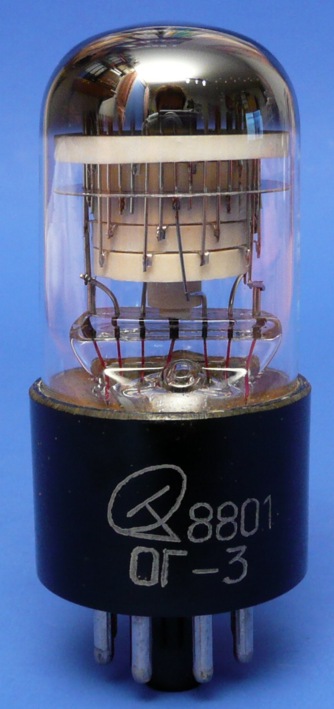
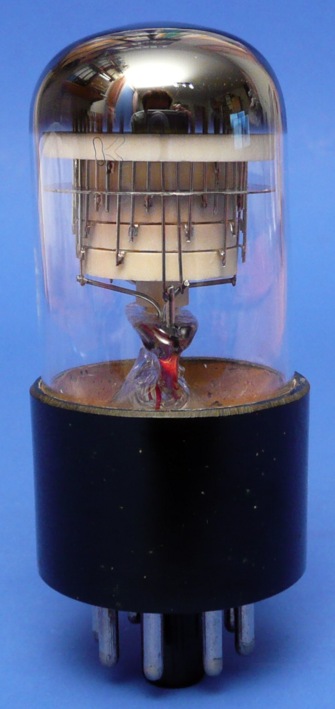
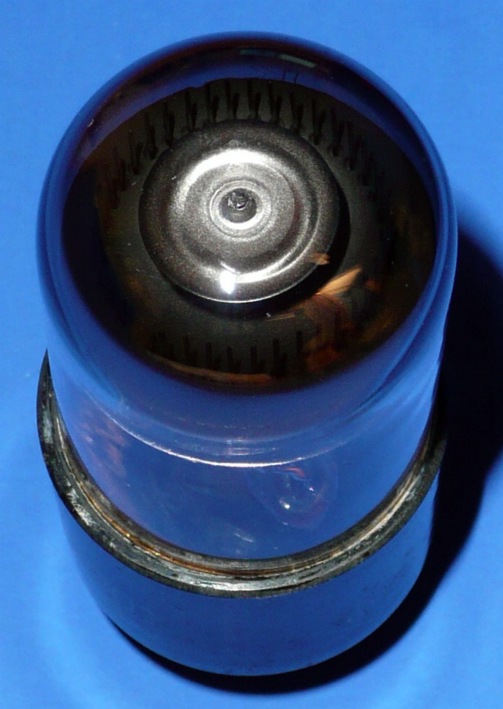

The following pictures show the tube spinning.
Of course, only one of the cathodes is glowing, but the shutter speed of the camera generates different pictures:
a high shutter speed of the camera:
a medium shutter speed of the camera:
a low shutter speed of the camera:
An animation sample of a spinning Dekatron (neon filled, colour not like the OG3!):
Röhrendaten/Tube Data:
| German | English | ||
| Röhrentyp | Tube type | O-G3 (ОГ-3) | |
| Hersteller | Brand | Анод, Дятьково, Россия (Anode, Dyatkovo, Russia) | |
| Vergleichstypen | Substitutes | – | |
| Zähl-Richtung | Counting direction | bidirectional | |
| Arbeitsweise | Operation | single pulse | |
| Art | Sort | counting tube | |
| Sockel | Base | K8A | |
| Fassung | Socket | K8A | |
| Nullposition | Zero position | Pin 1 | |
| Zähl-Schritte | Counting steps | 10 | |
| Anzahl der Hilfskathoden | Number of guides | 3 | |
| Gasfüllung | Gas filling | Argon | |
| Röhrendurchmesser maximal | Tube diameter max. | mm | 33 |
| Röhrenhöhe maximal | Tube height max. | mm | 76 |
| max. Zähl-Geschwindigkeit | Max. counting speed | kHz | 20 |
| Betriebsspannung minimal | Supply volt. min. | V | 420 |
| Betriebsspannung typisch | Supply volt. typ. | V | 450 |
| Brennspannung minimal | Maintaining voltage min. | V | 170 |
| Brennspannung typisch | Maintaining voltage typ. | V | 190 |
| Brennspannung maximal | Maintaining voltage max. | V | 210 |
| Anoden bzw. Kathodenstrom min. | Anode/cath. current min. | µA | 600 |
| Anoden bzw. Kathodenstrom typ. | Anode/cath. current typ. | µA | 700 |
| Anoden bzw. Kathodenstrom max. | Anode/cath. current max. | µA | 800 |
| Netzteil Leistung minimal | Power supply power min. | mW | 315 |
| Hilfskathodenvorspannnung minimal | Guide bias volt. min. | V | 40 |
| Hilfskathodenvorspannnung Impulsbetrieb typ. | Guide bias typ pulse op. | V | 40 |
| Hilfskathodenvorspannnung maximal | Guide bias volt. max. | V | 50 |
| Hilfskathodenimpulsspannung | Guide signal voltage pulse | Vp | 110-140 (125) |
| Hilfskathodenimpulsdauer minimal | Guide signal pulse duration min | µs | 17-22 |
| Resetimpulsdauer min. | Reset pulse duration min. | µs | 2-5 |
| Anschlussbelegung: | Pinout: | ||
| PIN 01 | PIN 01 | G3 | |
| PIN 02 | PIN 02 | K1-9 | |
| PIN 03 | PIN 03 | G2 | |
| PIN 04 | PIN 04 | NC | |
| PIN 05 | PIN 05 | G1 | |
| PIN 06 | PIN 06 | A | |
| PIN 07 | PIN 07 | Guide3 (K0) | |
| PIN 08 | PIN 08 | K0 |
Pinout, outline and typical application:
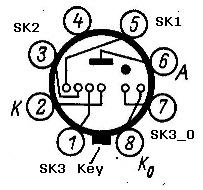
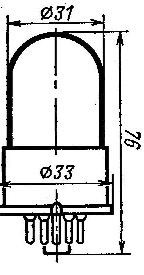

The OG-3 Dekatron Spinner by Dieter:
The following schematic shows how to use the tube for a Dekatron spinner.
If you don’t know what a Dekatron spinner is click here!
The circuit can be used at 100-125VAC/50-60 Hz or 210-240VAC/50-60Hz.

Downloads/Datasheets:
Sie finden passende Datenblätter im Datenblattarchiv.
Suchen sie dort nach dieser Type und deren Vergleichstypen.
You’ll find the matching datasheets in the datasheet archive.
Search for this type and its substitutes there.
Back to Dieter’s Nixie Tube Page
eMail to Dieter
Disclaimer
Impressum
я по технике читаю на этом языке и который снизу страницы тоже, а так перевести не проблема – в translate.google.com например.
Savel brain dump
(originalios biokronikos, nė lašo copy-paste) English « Spalvoti LCD ekraniukaiNokia N80 remontas »
Dekatronas
Turiu čia keletą tokių egzotiškų senu rusiškų lempučių A106. Tai didelio greičio dekatronas. Tokia dujų išlydžio lempa kuri skaičiuoja impulsus. Atitinkamai sujugus galina gauti tokį besisukantį taškelį. Deja rusiški dekatronai niekada nepasižymėjo dideliu stabilumu, todėl mano turimas dekatronas kartais sukasi, kartais prašoką kai kuriuos taškelius. Viskas dėl to, kad pajungimo schema supaprastinta.
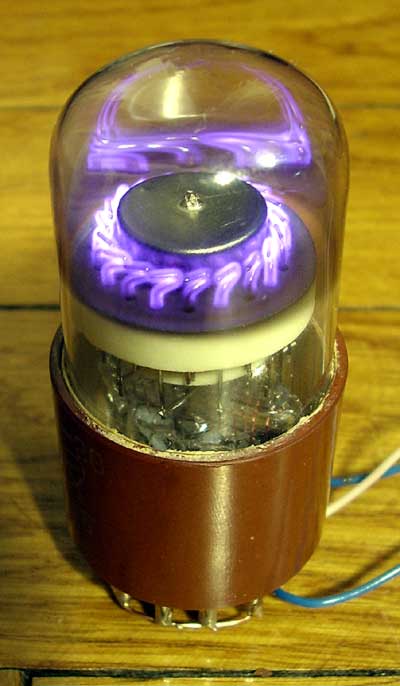
Nuotraukoje dektronas švyti visas. Dėlto, kad foto aparato išlaikymas didelis, o taškelis apibėga 5 kartus aplink per vieną sekundę (prie 50Hz tinklo). Va čia mažytis filmukas kaip bėga tas taškelis. Beja, taškelio spalva tikrai kitokia. ![]()
O štai čia mano supaprastinta schema. Dėmesio, ant schemos elementų vaikšto aukštos įtampos. Todėl schema rekomenduojama tik patyrusiems konstruotojams. Pati schema nieko įpatingo- įtampos daugintuvas ir vienas fazės pasukėjas.
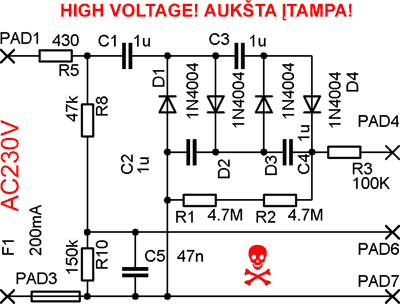
C1, C5- 250V, kiti kondikai 400V. R1 ir R2 skirti tik iškrauti kondikus kai prietaisas išjungiamas. Be jų, kondikai dar ilgai laiko įtampą ir duoda per nagus. Prie PAD1 ir PAD3 jungiam 230V, lemputė jungiasi: anodas prie PAD4, visi katodai sujungiami į vieną tašką ir jungiami prie PAD7, skaičiavimo elektrodas prie PAD6.
O šiaip, tai reklaminis straipsnis, nes noriu parduoti visus dekatronus per eBay.
- сейчас проще на 34063 (конечно кондер на киловольт к78-2 и диодик тоже кд226к ..л) Катушку умеет мотать любой радиолюбитель, феррит можно найти .
This entry was posted on Saturday, April 12th, 2008 at 9:03 pm and is filed under Betkas. You can follow any responses to this entry through the RSS 2.0 feed. You can leave a response, or trackback from your own site.
Leave a Reply
 (Jei ne skaičiai spauskit refresh. Tik oranžinius naudoti.)Enter Code (required)
(Jei ne skaičiai spauskit refresh. Tik oranžinius naudoti.)Enter Code (required)
Name (required)
Mail (will not be published) (required)
Website
- Informacija:
- Archyvai:
- March 2021
- February 2021
- January 2021
- December 2020
- November 2020
- October 2020
- September 2020
- August 2020
- July 2020
- June 2020
- May 2020
- April 2020
- March 2020
- February 2020
- January 2020
- December 2019
- November 2019
- October 2019
- September 2019
- August 2019
- July 2019
- June 2019
- May 2019
- April 2019
- March 2019
- February 2019
- January 2019
- December 2018
- November 2018
- October 2018
- September 2018
- August 2018
- July 2018
- June 2018
- May 2018
- April 2018
- March 2018
- February 2018
- January 2018
- December 2017
- November 2017
- October 2017
- September 2017
- August 2017
- July 2017
- June 2017
- May 2017
- April 2017
- March 2017
- February 2017
- January 2017
- December 2016
- November 2016
- October 2016
- September 2016
- August 2016
- July 2016
- June 2016
- May 2016
- April 2016
- March 2016
- February 2016
- January 2016
- December 2015
- November 2015
- October 2015
- September 2015
- August 2015
- July 2015
- June 2015
- May 2015
- April 2015
- March 2015
- February 2015
- January 2015
- December 2014
- November 2014
- October 2014
- September 2014
- August 2014
- July 2014
- June 2014
- May 2014
- April 2014
- March 2014
- February 2014
- January 2014
- December 2013
- November 2013
- October 2013
- September 2013
- August 2013
- July 2013
- June 2013
- May 2013
- April 2013
- March 2013
- February 2013
- January 2013
- December 2012
- November 2012
- October 2012
- September 2012
- August 2012
- July 2012
- June 2012
- May 2012
- April 2012
- March 2012
- February 2012
- January 2012
- December 2011
- November 2011
- October 2011
- September 2011
- August 2011
- July 2011
- June 2011
- May 2011
- April 2011
- March 2011
- February 2011
- January 2011
- December 2010
- November 2010
- October 2010
- September 2010
- August 2010
- July 2010
- June 2010
- May 2010
- April 2010
- March 2010
- February 2010
- January 2010
- December 2009
- November 2009
- October 2009
- September 2009
- August 2009
- July 2009
- June 2009
- May 2009
- April 2009
- March 2009
- February 2009
- January 2009
- December 2008
- November 2008
- October 2008
- September 2008
- August 2008
- July 2008
- June 2008
- May 2008
- April 2008
- March 2008
- February 2008
- January 2008
- December 2007
- November 2007
- October 2007
- September 2007
- August 2007
- July 2007
- June 2007
- May 2007
- April 2007
- March 2007
- February 2007
- January 2007
- December 2006
- November 2006
- October 2006
- September 2006
- August 2006
- July 2006
- June 2006
- May 2006
- April 2006
- March 2006
- February 2006
- January 2006
- December 2005
- November 2005
- October 2005
- September 2005
- August 2005
- July 2005
- June 2005
- May 2005
- Kategorijos:
- Analogue (30)
- Asmeniniai (82)
- Bambesiai (139)
- Betkas (955)
- Chemija (28)
- FPGA/CPLD (49)
- HV (10)
- Indukcinis kaitinimas (24)
- Laser Cut (18)
- Lazeriai (31)
- LED (71)
- MCU (159)
- Vandalizacija (135)
- Add
馬 - DĖMESIO! FEISBUKU NESINAUDOJU. Tai tik mados reikalas:
- Reklamos turinys nekontroliuojamas:
Make bottom horse more happy:

- DĖMESIO! FEISBUKU NESINAUDOJU. Tai tik mados reikalas:
Savel brain dump is proudly powered by Savel.
Tai internetinis dienoraštis apie elektroniką (savadarbė irgi aprašoma), chemiją (netgi ir pavojinga),
programavimą (nuo MS visual basic iki klasikinės C iki mikrokontrolerių “mikrovaldiklių”)
ir aišku asmeniniai bambesiai apie visą pasaulį ir šiaip mizantropiją.
© by Levas Vabolis. Daugiau informacijos čia ir čia.
Kopijuoti draudžiama. Komentarai redaguojami. Prieš komentuojant pažiūrėkit į data!
Tai asmeninis puslapis ir jame paskelbta informacija tėra tik asmens nuomonė. LRK 25, 42 str.
Entries (RSS) and Comments (RSS). переводим в интернете. тут мне тоже не сильно понятно, хоть язык ближе к польскому.

This is my first time pay a visit at here and i am actually
pleassant to read everthing at alone place.
I got this site from my buddy who shared with me on the topic of this site and now this time I am visiting this
website and reading very informative articles or reviews at this time.
Now I am going away to do my breakfast, afterward having my
breakfast coming over again to read more news.ラブドール エロ